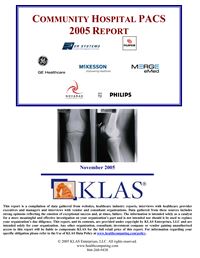 2025 BEST IN KLAS
2025 BEST IN KLAS
Preferences
Related Series
Related Segments


PACS 2020
Ability to Scale Drives Decisions, with an Eye on Enterprise Imaging
The PACS market is currently an evolving, dynamic space ripe for disruption—many provider organizations are replacing legacy PACS solutions and enterprise imaging (EI) is on the rise. As provider organizations examine potential vendor partners, the following three considerations are top of mind:
- Are current customers satisfied (and does the vendor deliver consistently regardless of client volume)?
- Can the vendor scale to meet the complex needs of large-volume organizations?
- What is the vendor’s EI strategy and how well can they provide EI guidance?
What Is Enterprise Imaging?
For the purposes of this research and in partnership with provider experts, KLAS defines enterprise imaging (EI) as the ability to store and/or view images across the enterprise from more than one service line or organization.
Overall PACS Performance, Scalability, and EI Strategy
The following is a high-level view of vendor performance across the three areas introduced above, showing each vendor’s ability (or inability) to meet customer expectations. Subsequent sections dive deeper into how well vendors perform in each individual area.

PACS PERFORMANCE & CONSISTENCY
Sectra and Change Healthcare Consistently Perform Well across Image Volumes
Regardless of their imaging volume, Sectra and Change Healthcare customers report high satisfaction with product quality and functionality. While adoption of the vendors’ other EI solutions (e.g., VNAs) is still early, both vendors are moving customers toward the EI approach. Sectra has a long-standing presence in small-volume organizations and has recently had success signing large-volume sites (>300K). Clients of all sizes say the solution is easy to use and a “workhorse.” Despite some nickel-and-diming, large-volume customers often describe Sectra as a partner. Change Healthcare respondents report solid functionality. Large-volume customers highlight a “configurable user experience” that integrates the full study process across various workflows. However, customers feel Change Healthcare is starting to fall behind the market in terms of continuing development. Most Philips (Carestream) and INFINITT customers are at <300K studies per year, though both products have expanded into the large-volume space. Philips’ (Carestream) performance is fairly consistent across volumes. INFINITT performs well for large-volume clients, though growing pains have created some support inconsistency. Looking forward to EI, a few large-volume customers have adopted INFINITT’s VNA, and Philips recently announced the Carestream solutions as their go-forward for EI (no transitions from IntelliSpace yet validated).


—Manager of radiology, large-volume organization

—Manager of radiology, large-volume organization
ABILITY TO SCALE TO LARGE IMAGING VOLUMES
Change Healthcare, Fujifilm, Philips IntelliSpace Scale to >500K; Performance Is Middle of the Road
Especially in the large-volume space, many vendors fail to excel. Agfa HealthCare, Change Healthcare, GE Healthcare, Fujifilm, IBM Watson Health, and Philips IntelliSpace are all frequently used by customers with volumes >500K (who often have an EI strategy) and are often considered in PACS purchases. Fujifilm’s PACS meets client needs and is easy to use but has some system-performance issues; resulting support is reactive, and personnel struggle to answer more advanced questions. Large-volume Change Healthcare customers report slow or insufficient development with potential for the PACS becoming outdated. Philips IntelliSpace clients report good basic functionality but feel Philips does not push the development envelope.
Large-volume clients (including >500K) of GE Healthcare and Agfa HealthCare are significantly less satisfied than small-volume peers. Large-volume GE Healthcare customers express deep frustration, mostly around functionality—as a result, 70% would not buy the PACS again. Clients describe a clunky product that lacks modern functionality. Interviewed large-volume clients on Agfa Enterprise Imaging for Radiology (all >500K) say Agfa is moving in the right direction by communicating and taking ownership and has worked to stabilize and now optimize the solution and fully implement promised capabilities. Customers that have been live longer than two years are often most dissatisfied—they feel the platform was released too soon. Agfa’s IMPAX solution is now a legacy product, though it still has significant market share; almost all leaving it are considering a transition to Agfa’s EI platform. IBM Watson Health clients on the Merge PACS platform (proven to scale) share frustration about their solution. Since the acquisition, clients have seen increased communication gaps and red tape. Customers also feel the road map is unclear.
For >300K, Sectra and Intelerad (Mostly Imaging Groups) Excel in Key Metrics
Sectra partners with large-volume customers (>300K, with a few >1M) through engaged vendor leadership and teams, on-site visits, and involvement in strategic direction. They also receive strong support (though support is sometimes a pain point for smaller-volume clients). Overall, clients praise Sectra for basing development on customer needs and requests. Intelerad, validated mostly in imaging groups, has many large-volume customers (with a handful over 1M). These organizations appreciate the concierge-style support they receive and feel frontline staff is empowered to solve problems. Respondents also say Intelerad is “always moving” with development. Smaller-volume clients are less satisfied and feel they are not Intelerad’s main focus.


EI STRATEGY & GUIDANCE
EI Partnership an Important Factor in PACS Decisions—Is Your Vendor a Partner across Imaging Solutions?
Regardless of imaging volume, many organizations view a vendor’s enterprise imaging approach as a major factor in PACS purchasing decisions, though there is not yet an established path to achieve EI. KLAS’ latest EI report found that organizations using other systems (i.e., VNA or universal viewer) from their PACS vendor were more likely to see the vendor as a strategic partner and a valuable resource for EI across services lines. When provider organizations are building out an EI strategy, they should consider their PACS vendor’s broader imaging portfolio as well as the vendor’s ability to provide strategic guidance across imaging solutions.


For more insights on vendor performance in enterprise imaging, see KLAS’ 2019 and 2018 EI reports. To learn more about KLAS’ upcoming enterprise imaging summit, contact Monique Rasband at monique.rasband@klasresearch.com.
With Large EI Customer Bases, IBM Watson Health and Agfa HealthCare Seen as Strategic Partners

Fujifilm customers taking an EI approach tend to have less adoption outside radiology. They report some strategic guidance from Fuji; however, they struggle to get specific, effective operational support. Additionally, compared to other vendors’ EI clients, they report fewer outcomes related to the VNA and universal viewer. Customers are looking forward to Fuji bringing their siloed products together into a unified platform, though Fuji is still early in that process. Philips’ (Carestream) EI footprint is small. These clients are highly satisfied overall; they tend to have lower volumes and not be deployed widely outside radiology.

Writer
Amanda Wind

Designer
Jess Wallace-Simpson

Project Manager
Robert Ellis
This material is copyrighted. Any organization gaining unauthorized access to this report will be liable to compensate KLAS for the full retail price. Please see the KLAS DATA USE POLICY for information regarding use of this report. © 2026 KLAS Research, LLC. All Rights Reserved. NOTE: Performance scores may change significantly when including newly interviewed provider organizations, especially when added to a smaller sample size like in emerging markets with a small number of live clients. The findings presented are not meant to be conclusive data for an entire client base.























